8 World’s Rarest Fish Species. Concerns have been expressed regarding the detrimental effects that excessive fishing has had on a variety of marine species as well as the natural ecosystems they inhabit over the previous several decades.
As a direct consequence of this, some types of fish are now recognized as belonging to the category of being “critically endangered” and are becoming increasingly uncommon in their natural environments.
Nearly all of the wild populations of the rare fish on this list have been wiped off because people continue to take more fish than what is ecologically sustainable.
Even though there are various rules in place that protect these endangered fish from future dangers, many of them have not yet recovered in their natural environments.
However, there has been some progress made towards the recovery of a few of the fishes on this list as a result of substantial conservation efforts.
1. European Sea Sturgeon (Atlantic Sturgeon)
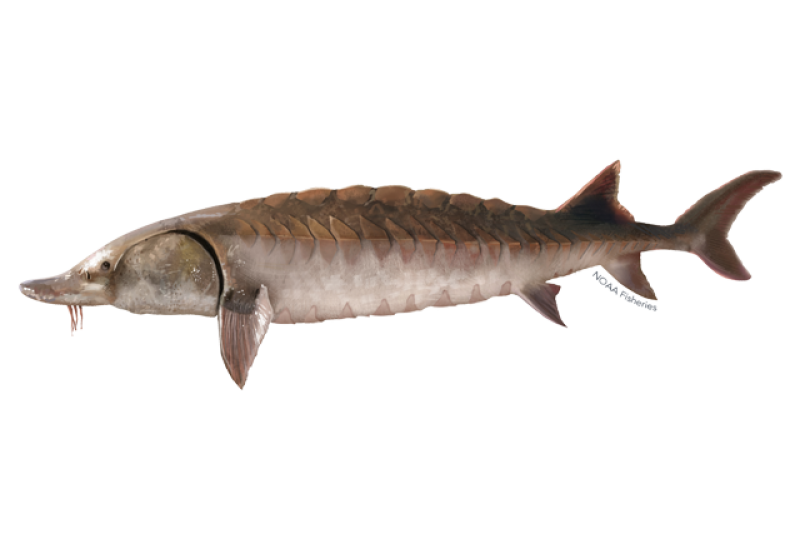
- Current Estimated Numbers: 20 – 750 adults in the wild; thousands from captive stock
- Range (Location): Garonne River, France
- Size of Range: 10 km² (3.86 mi²)
- Scientific Name: Acipenser sturio
- Conservation Status: Critically Endangered (CR)
The European Sea Sturgeon, which is also referred to as the Atlantic Sturgeon (but should not be confused with the other species of Atlantic Sturgeon, which is called Acipenser oxyrinchus oxyrinchus), is an extremely uncommon species of fish that can only be found in the Garonne River in France.
The historical range of the European Sea Sturgeon included the North Sea, the Baltic Sea, the English Channel, the European shores of the Atlantic Ocean, the northern Mediterranean to the west of Rhodos, and the western and southern Black Sea.
In addition to this, there were rumors that the European Sea Sturgeon was discovered close to the coasts of Morocco, Tunisia, and Algeria.
There are around 20–750 mature European Sea Sturgeons left in their natural habitats today. On the other hand, every year a few thousand fish that were bred in captivity are released back into their natural environments.
These European Sea Sturgeon were at one time kept as pets, but they have not yet reproduced in the wild.
2. Smalltooth Sawfish
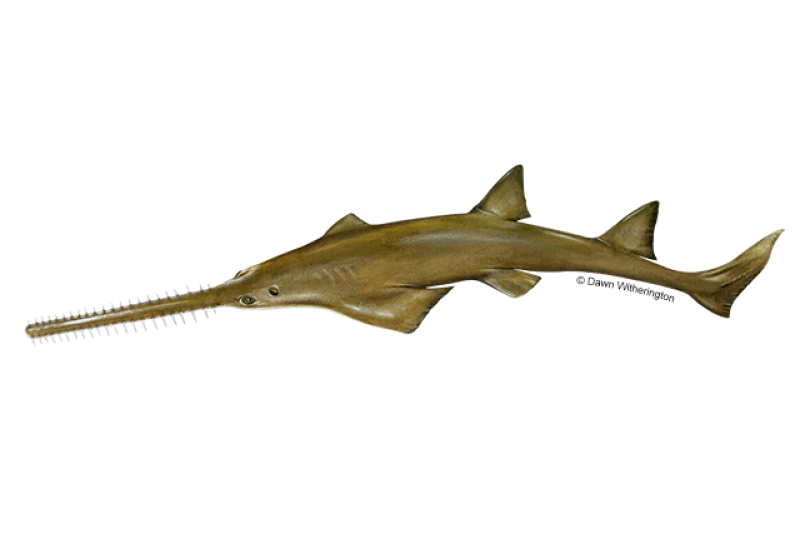
- Current Estimated Numbers: Possibly extinct in several previously known areas; total global population unknown; about 269 – 505 in the U.S.
- Range (Location): Bahamas; Belize; Cuba; Honduras; USA; and Sierra Leone
- Size of Range: Unspecified
- Scientific Name: Pristis pectinata
- Conservation Status: Critically Endangered (CR)
Sawfish is an interesting-looking species of fish that gets its name from its long snout that resembles a blade.
Smalltooth Sawfish are found in the Pacific Ocean. The Smalltooth Sawfish is a member of the ray family, which is comprised of cartilaginous fish, despite the fact that it appears to be a shark.
In the distant past, tropical and subtropical seas in the western and eastern Atlantic Oceans were home to a substantially larger population of smalltooth sawfish than they are today.
At this time, the Smalltooth Sawfish can only be reliably found off the coast of Florida and around several islands in the Bahamas. Other than those two locations, it has become extinct everywhere else.
According to the IUCN Red List, the Smalltooth Sawfish has most certainly become extinct in a significant number of the places it had previously been known to inhabit.
Since around 1962, it is suspected that more than 95% of the Smalltooth Sawfish population has been eliminated completely.
The wild population of smalltooth sawfish was eradicated as a result of targeted fishing, and many of the fish continue to be caught in nets that were intended for other species of fish.
3. Kissing Loach
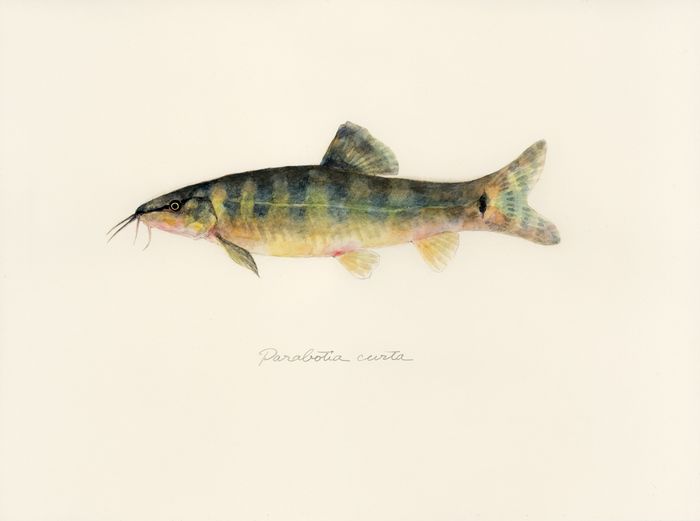
- Current Estimated Numbers: fewer than 800
- Range (Location): Kameoka City and Okayama City, Japan
- Size of Range: 12 km² (4.63 mi²)
- Scientific Name: Parabotia curtus
- Conservation Status: Critically Endangered (CR)
The Kissing Loach, also known as Aymodoki in Japanese, is a species of loach that is endemic to just three remote and remote locations in Japan.
At this point in time, the only reason why the Kissing Loach has not become extinct is due of the tremendous intervention and conservation efforts made by humans.
The IUCN Red List states that the Kissing Loach is on the verge of being considered extinct in the wild, however for the time being, this species is still regarded to be highly endangered.
According to the IUCN Red List, if there were ever to be a time when conservation efforts were discontinued for any reason, it is believed that all of the existing populations of Kissing Loach would perish.
There are likely less than 800 Kissing Loaches still alive, according to estimates. The city of Kameoka, which is home to the greatest concentration of Kissing Loaches, is going to get a new park, and within that park, there are plans to construct a conservation area.
Volunteers in Okayama City are making sure that the region’s two populations of Kissing Loach continue to spawn on an annual basis.
4. Giant Sea Bass
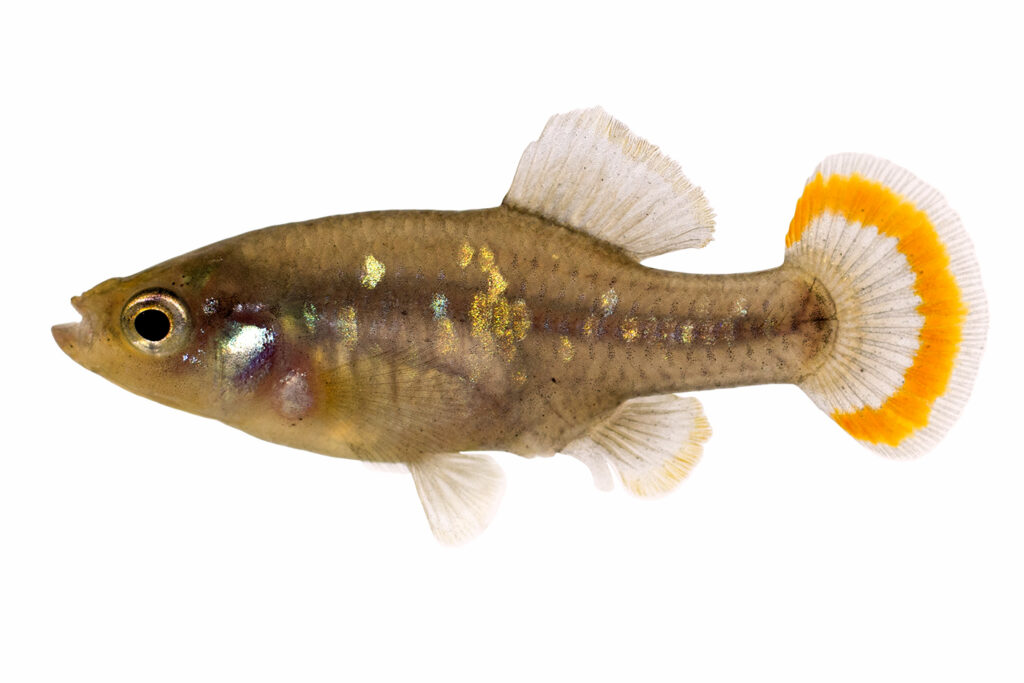
- Current Estimated Numbers: about 500
- Range (Location): Eastern Pacific (from Humboldt Bay, California, USA to the tip of Baja, Mexico; also in the northern half of the Gulf of California)
- Size of Range: Unspecified
- Scientific Name: Stereolepis gigas
- Conservation Status: Critically Endangered (CR)
The Giant Sea Bass was previously plentiful along the coast of California and Baja, Mexico; but, due to overfishing in recent decades, the population of this fish has nearly been driven to extinction.
It is believed that the Giant Sea Bass is on the verge of making a recovery with the assistance of vigorous conservation efforts.
However, the current population of this species in the wild is only thought to consist of about 500 mature individuals at this time.
The Giant Sea Bass is a huge species of fish that can reach a maximum size of around 600 pounds (272.16 kilograms), as suggested by its name.
The Southern California kelp forests are home to some of the largest predators in the world, and giant sea bass are among them.
In the past, Giant Sea Bass were much more frequent and, as a result of their tendency to cluster in big groups, they were also much easier to fish for.
During the summer of 2018, researchers from the University of California, Santa Barbara, and the Aquarium of the Pacific confirmed the presence of a population of Giant Sea Bass in Avalon’s Casino Dive Park, which is a well-known location for scuba diving.
5. Tequila Splitfin
- Current Estimated Numbers: fewer than 500
- Range (Location): Rio Teuchitlan of the Rio Ameca drainage in Mexico
- Size of Range: A single pool 4 m (13 ft) in diameter
- Scientific Name: Zoogoneticus tequila
- Conservation Status: Critically Endangered (CR)
A little fish called the Tequila Splitfin can only be found in a spring pool in Rio Teuchitlan, which is located in Mexico.
Due to the lack of specimens uncovered by collection attempts since 1992, scientists came to the conclusion that the Tequila Splitfin has become extinct.
However, in 2005, the discovery of the sole known remnant population of Tequila Splitfins was made.
It is thought that there may only be a total of approximately 500 Tequila Splitfins left in this group, with only 50 of them being adults.
The wild population of Tequila Splitfins is currently being assisted by a number of conservation measures, which is a fortunate development.
The Mexican Fish Ark, which is housed at the University of Michoacana de San Nicolás de Hidalgo, has proven successful in the reproduction of various endangered species of fish, one of which is the Tequila Splitfin.
Around 700 Tequila Splitfins were put back into the wild by conservationists in 2017, in the hopes that the species will be able to make a full recovery.
6. Adriatic Sturgeon
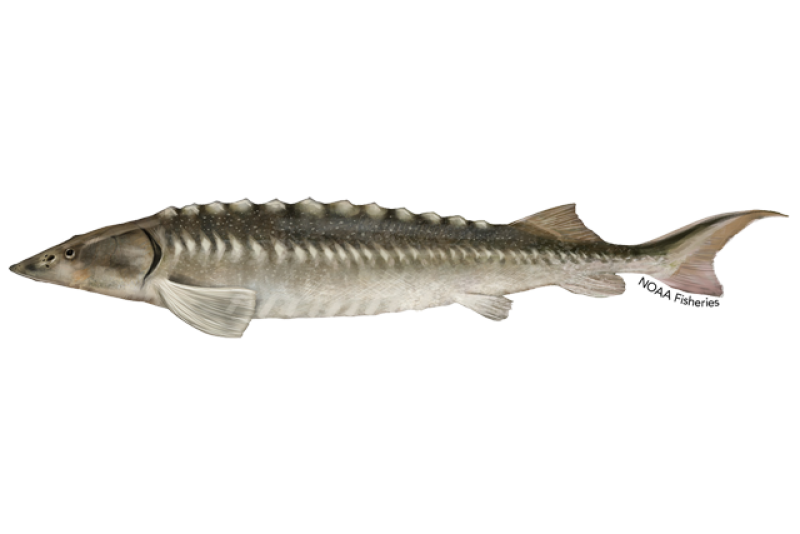
- Current Estimated Numbers: fewer than 250; may be functionally extinct in the wild
- Range (Location): Adriatic Sea (fresh waters of the northern part of Italy and the eastern coasts of the Adriatic Sea)
- Size of Range: 1 – 10 km² (0.39 – 3.86 mi²)
- Scientific Name: Acipenser naccari
- Conservation Status: Critically Endangered (CR)
In times past, the Adriatic Sturgeon lived throughout a greater portion of the Adriatic Sea and was found in greater numbers.
However, overfishing in the Adriatic over the course of the last few decades has wiped out the wild population of sturgeon, and it is possible that there are fewer than 250 wild fish left.
According to the IUCN Red List, the Adriatic Sturgeon has already become extinct in a significant number of the areas that it once inhabited.
Since 1988, the Adriatic Sturgeon has been propagated in fish farms with great success, and the population of this species in Italy is constantly being supplied.
Regrettably, there is no evidence that the fish that were released are reproducing in their natural environment.
For the past fifteen years, there is no evidence that the Adriatic Sturgeon has been reproducing in the locations where it is typically found.
7. Devils Hole Pupfish
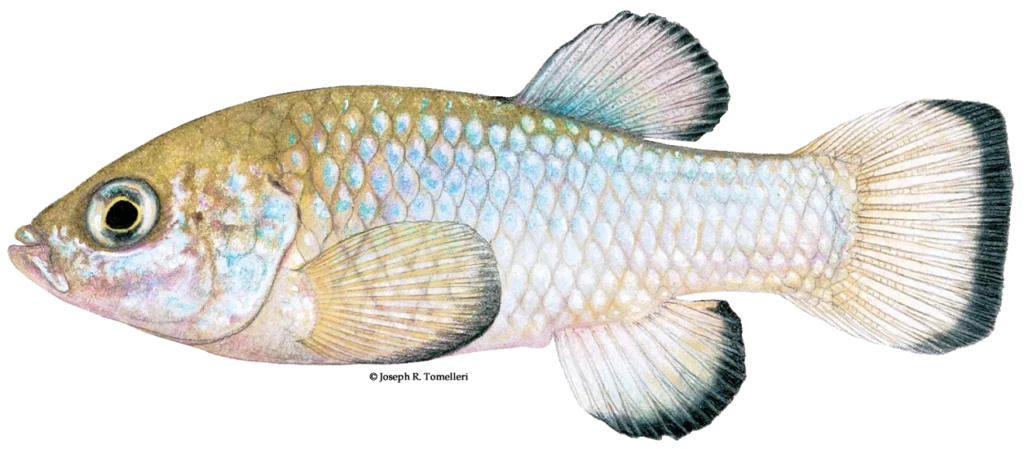
- Current Estimated Numbers: about 187
- Range (Location): Devils Hole, Ash Meadows, Death Valley National Park, Nevada, USA
- Size of Range: Unspecified (smallest geographic range on any vertebrate)
- Scientific Name: Cyprinodon diabolis
- Conservation Status: Critically Endangered (CR)
In spite of the fact that this list and our research demonstrate otherwise, it is commonly believed that the Devil’s Hole Pupfish is the rarest fish in the world (although it is not quite as rare as the Red Handfish).
The Devil’s Hole Pupfish is endemic to a single geological feature in Death Valley National Park in Nevada known as the Devil’s Hole.
This park is also known as Nevada’s Badwater Basin. It is estimated that the Devil’s Hole Pupfish has been cut off from the rest of the world for somewhere between 10,000 and 20,000 years in this region.
In general, the population of Devils Hole Pupfish has always been on the lower end. The amount of algae that live on the rock shelf at Devil’s Hole is thought by researchers to have some influence on their population numbers.
In the month of October 2018, researchers counted approximately 187 Devils Hole Pupfish, which is the most number they’ve seen in the area in the past 15 years.
8. Red Handfish
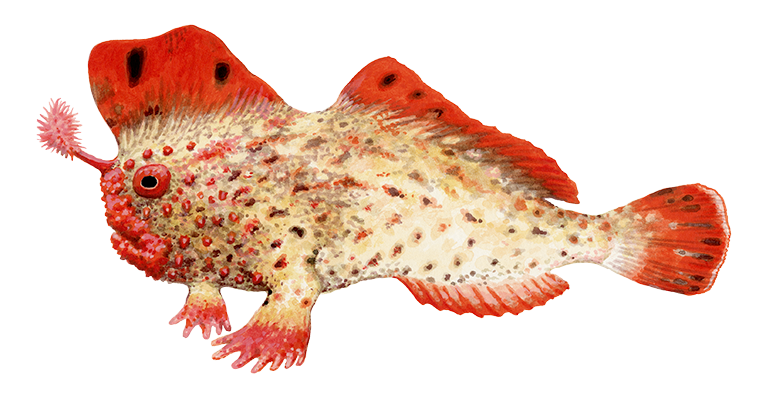
- Current Estimated Numbers: 40 – 80
- Range (Location): Coastal waters off eastern Tasmania
- Size of Range: Unspecified
- Scientific Name: Thymichthys politus
- Conservation Status: Critically Endangered (Australian Conservation Status; not listed on IUCN Red List)
The Red Handfish is a peculiar-looking species of fish that moves through the ocean floor with the help of its hand-shaped fins.
Since its discovery in the 1800s, the Red Handfish has never had more than a few hundred individuals in its population.
Up until the beginning of 2018, it was believed that there was just one group of approximately 20–40 Red Handfish residing in Hobart’s Frederick Henry Bay, which is located off the coast of eastern Tasmania.
Early in 2018, a research group from the Institute of Marine and Antarctic Studies at the University of Tasmania found a second group of Red Handfish.
Because of this recent find, the total number of Red Handfish believed to exist has increased to roughly 80 individuals.
The Red Handfish is a species that is considered to be severely endangered. The reason for this is that the eggs that the Red Handfish lays on the bottom of seaweed are frequently disturbed when other marine creatures or people move through the area where the eggs are located.
https://www.newshub360.net/humix/video/beh7s6yyXzf
8 World’s Rarest Fish Species – Newshub360.net
Related Post
Credit: www.Newshub360.net

